Hi, my name is Chris Englezou, I am the founder of C.E. Fish Essentials; the first company to produce high quality formulated frozen diets for ornamental fish species. I have a background in biological and nutritional sciences with a special interest in fish nutrition. I have been a fish keeper since the early 90’s, almost 25 years soon and have kept and bred many aquarium species. Fish-keeping (but particularly Discus keeping) was introduced to me at a very early age, my father kept and bred discus in the early 90’s and this was my earliest introduction to the Discus hobby. For the last 15 years I have been particularly interested in the concept of Biotope Aquariums and house all of my fish in this way. After my recent research trip to South America I am convinced that to get the best out of any fish species and see all of their natural behaviours, you must recreate the conditions within which they have evolved over thousands and thousands of years; I believe this is the only way to truly understand them.
- Tell us something about your amazing food. How did you decide to make a CE Fish business, when we all know every breeder and keeper can make his own mix.
The research and conception of C.E. Fish Essentials occurred in early 2008 and came to fruition two years later, the popularity was immense and it is now a brand which is consistently associated with authenticity, quality and trust. The idea arose out of several reasons, namely because when you understand how particular and consequential the addition of, and quantity of any ingredient as part of a regular single food source is, as well as the histological behaviour of their respective compounds and by-products within the microscopic anatomy, you are then faced with the reality of the haphazard nature of discus food preparation as it exists today. This is something which I struggled to ignore and was compelled to do something about.
In short, the answer is no. A mixture is just a combination of two or more ingredients and since the preparing of amateur foods for discus became popularised the method is to add X amount of X ingredients and that “variety” is most important; even the addition of vitamins suitable for humans has been widely accepted as suitable despite the immense damage which can be caused. This was one of the biggest reasons which compelled me to investigate, research and formulate foods which work in better physiological harmony with the fish and do not cause internal damage or stress. The difference between a mixture and a formulation is by far one of the most ignored and misunderstood concepts in the fish keeping community.
- What is most important ingredient in discus food?
My personal feelings are that there is no single magical ingredient which is most important when feeding discus fish and there are different considerations which must be taken into account and offset against their realistic use within the contained aquarium environment. The most crucial thing is to look at the natural diet of the fish and determine how the fish benefits (and survives) as a result of these food choices; then we can try to emulate and improve that in the hobby as best as is possible. Responsible and informed selection of compatible substitute ingredients is without doubt, vital. Ingredients which not only respect and support the efficient functioning of the fish’s anatomy but also those which aid it should be considered first; equally important is the research (both laboratory and field) as well as composition and overall formulation. The wide-spread consensus is that Discus are a detritivorous species, because it is the food ‘item’ which is found in highest quantities in their natural diet, but to begin identifying their preferred food sources, I feel we must look to the items they select when food is abundant, rather than solely those they consume in their desperate foraging attempts to survive a harsh dry season, during which the majority go with empty stomachs for several months through obligation rather than choice. Baring this in mind, it is plant material, including specific Amazonian fruits, flowers and algae which are by far the primary choice of Discus fish. Yet, their incredible digestive adaptability is likely due to both the different types of food items they commonly feed on and their differing respective nutritional attributes, as well as the opportunistic nature the fish must employ during times of scarcity when they feed mostly on detritus or nothing at all. On a broader scale, being able to understand how the water systems function in Amazonia, as well as understanding when the trees which are repeatedly found in Discus habitats bare fruit, alongside several other influential factors which control access to food are imperative considerations for a clearer insight to what would be ‘correct’ Discus nutrition. It is clear that a great deal more information is required before we have a single formula which is perfect for discus, but it is something which I have been working on for some years and hope to achieve in my lifetime.
- Can food be trigger for spawning wild altums and discus fishes. And other fishes.
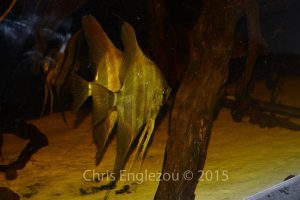 I’d say ‘access’ to an ample supply of food is most certainly something which contributes to the triggering of spawning behaviour in most fish species, although naturally this must go hand in hand with an optimum breeding environment which must be additional to stable, ‘more-than-suitable’ living conditions. With respect to Symphysodon and Pterophyllum, species which have adapted to a high/low water seasonal environment, the coming of the rain season signifies not only abundance of food; it simultaneously provides renewed access to breeding grounds. It is important to understand that the planet (not just the habitats of fish) has evolved this way over many millions of years. Landscapes, plants, animals and the fish have adapted to their environments as they changed and everything in these last free places on Earth still operates in this cooperative and symbiotic way. The plants rely on the rain season to bare fruit; the fish rely on the rain season to recreate their favoured conditions and to get access to their breeding places as well as relying on the submersion of terrestrial areas and the fruiting of the trees to provide their foods. Some plants even rely on fish to distribute their seeds! So whilst food is a pivotal factor in the breeding of Discus and Altums we have to understand that there is a much bigger picture which determines the suitability of a species to provide nature with another generation. It is one big cooperative system adapted to maintain the natural balance of how ‘Life’ operates in these respective regions. Scientifically, the ability of food to trigger spawning is as equally related to correct nutrition as it is to abundance of food, and in the case of Symphysodon, research suggests that ability to spawn is dependant on hierarchical status within the group. Research by Crampton found that in a collection of 282 Discus fish, 25 of the 46 individuals (of both sexes) that exhibited ‘Royal’ colouration also had sexual organ development at stages 3-5 (5 maximum) and all 46 had development of stage 2 or above. The most interesting part is that only 4 of these 25 had stage 3, 20 had stage 4 and only 1 had stage 5 development. It appears to support the indication in Bleher’s work that a single (always ‘Royal’) discus is the dominant leader of a group and I would go as far as to suggest that this individual would be the most virile or at very least be the most desirable choice of mate within the group. So to summarise; abundance, composition and quality of food are one group of a few important contributing factors which control the ability of Discus to breed.
I’d say ‘access’ to an ample supply of food is most certainly something which contributes to the triggering of spawning behaviour in most fish species, although naturally this must go hand in hand with an optimum breeding environment which must be additional to stable, ‘more-than-suitable’ living conditions. With respect to Symphysodon and Pterophyllum, species which have adapted to a high/low water seasonal environment, the coming of the rain season signifies not only abundance of food; it simultaneously provides renewed access to breeding grounds. It is important to understand that the planet (not just the habitats of fish) has evolved this way over many millions of years. Landscapes, plants, animals and the fish have adapted to their environments as they changed and everything in these last free places on Earth still operates in this cooperative and symbiotic way. The plants rely on the rain season to bare fruit; the fish rely on the rain season to recreate their favoured conditions and to get access to their breeding places as well as relying on the submersion of terrestrial areas and the fruiting of the trees to provide their foods. Some plants even rely on fish to distribute their seeds! So whilst food is a pivotal factor in the breeding of Discus and Altums we have to understand that there is a much bigger picture which determines the suitability of a species to provide nature with another generation. It is one big cooperative system adapted to maintain the natural balance of how ‘Life’ operates in these respective regions. Scientifically, the ability of food to trigger spawning is as equally related to correct nutrition as it is to abundance of food, and in the case of Symphysodon, research suggests that ability to spawn is dependant on hierarchical status within the group. Research by Crampton found that in a collection of 282 Discus fish, 25 of the 46 individuals (of both sexes) that exhibited ‘Royal’ colouration also had sexual organ development at stages 3-5 (5 maximum) and all 46 had development of stage 2 or above. The most interesting part is that only 4 of these 25 had stage 3, 20 had stage 4 and only 1 had stage 5 development. It appears to support the indication in Bleher’s work that a single (always ‘Royal’) discus is the dominant leader of a group and I would go as far as to suggest that this individual would be the most virile or at very least be the most desirable choice of mate within the group. So to summarise; abundance, composition and quality of food are one group of a few important contributing factors which control the ability of Discus to breed.
- How do you test new products?
We have worked closely with our research and development partner company since we officially launched in early 2010. We invest an annual amount into the trial and analysis of our feed formulations and this involves prolonged laboratory research into how our products and even individual ingredients perform in feed trials. Through this research we are able to ascertain the suitability of a product for use with particular genera or as a broad spectrum feed as well as gauge the efficiency of feed conversion and other considerations. Personally, I also work with individual breeders and hobbyists in the fish-keeping community to ensure I have a good understanding of the practical use of products as well as any flaws / problems which may arise and relay this back into product development.
Do you keep discus in the moment and what is your favorite variety. We saw that you keep wild Altums.
 At the moment, my fish collection is much smaller than it used to be, I currently keep a 1000L (183cm L x 91cm W x 64cm H) Rio Atabapo Biotope aquarium with only wild fish. I have 8 Uaru fernandezyepezi and 6 Pterophyllum altum. I soon hope to add some other species, which I saw on my recent journey to the Atabapo river but am yet to decide… Potentially they will be Iguanodectes geisleri, possibly Mesonauta egrigius, and a group of Dekeyseria brachyura with a few individuals of the species, Pseudolithoxus anthrax. I also keep a group of F1 Parancistrus aurantiacus, they are the first of this species to be bred in the UK (and possibly Europe). A close friend and customer received two pairs of wild caught fish which were captured in the Rio Araguaia by fishermen working for Hudson Crizanto (H&K Ornamental Fish) in Brasil. He began feeding them with one of our Loricariid formulations and within a few months had the first fry. They continued to breed several times and the fry were raised on a unique formulation for Loricariid fry which I prepared especially until they were older. I was offered some of the fry and it was a privilege for me to take them. An account of the breeding and development can be found here: http://www.cefishessentials.com/blog/1st-u-k-breeding-of-parancistrus-aurantiacus/
At the moment, my fish collection is much smaller than it used to be, I currently keep a 1000L (183cm L x 91cm W x 64cm H) Rio Atabapo Biotope aquarium with only wild fish. I have 8 Uaru fernandezyepezi and 6 Pterophyllum altum. I soon hope to add some other species, which I saw on my recent journey to the Atabapo river but am yet to decide… Potentially they will be Iguanodectes geisleri, possibly Mesonauta egrigius, and a group of Dekeyseria brachyura with a few individuals of the species, Pseudolithoxus anthrax. I also keep a group of F1 Parancistrus aurantiacus, they are the first of this species to be bred in the UK (and possibly Europe). A close friend and customer received two pairs of wild caught fish which were captured in the Rio Araguaia by fishermen working for Hudson Crizanto (H&K Ornamental Fish) in Brasil. He began feeding them with one of our Loricariid formulations and within a few months had the first fry. They continued to breed several times and the fry were raised on a unique formulation for Loricariid fry which I prepared especially until they were older. I was offered some of the fry and it was a privilege for me to take them. An account of the breeding and development can be found here: http://www.cefishessentials.com/blog/1st-u-k-breeding-of-parancistrus-aurantiacus/
My Discus collection is very small nowadays; I have  reduced my collection to one pair of F1 Xingu Discus, which are part of a unique breeding project I am working on with the ‘Xinguary’ guys from Hungary. In a group of two unrelated batches of Xingu F1’s I received from Nandi Hivatal (The Xinguary) in 2009, I identified one sibling pair which both exhibited a unique trait. They completely lack all expression of red pigment (eyes, base colour, fins… everything!) Usually this is not particularly sought out in discus, the consensus is that red eyes are better and more colour = better. But as the discus of the Xingu region are the most golden of all and renowned for lacking body patterning but compensating for this with their exceptional base colour and blue/black halo ring, this trait which accentuates the golden colour of the wild form is interesting to us and we have 2 projects which will commence to try to responsibly fix this trait with a suggested 1:1 line-breeding and out-crossing system. I am also working on another long term project examining and identifying the skeletal deformation of bulldog discus. As a result of this project, through which I have worked with a number of professional veterinary specialists, we are hoping to determine scientifically, why and how this occurs.
reduced my collection to one pair of F1 Xingu Discus, which are part of a unique breeding project I am working on with the ‘Xinguary’ guys from Hungary. In a group of two unrelated batches of Xingu F1’s I received from Nandi Hivatal (The Xinguary) in 2009, I identified one sibling pair which both exhibited a unique trait. They completely lack all expression of red pigment (eyes, base colour, fins… everything!) Usually this is not particularly sought out in discus, the consensus is that red eyes are better and more colour = better. But as the discus of the Xingu region are the most golden of all and renowned for lacking body patterning but compensating for this with their exceptional base colour and blue/black halo ring, this trait which accentuates the golden colour of the wild form is interesting to us and we have 2 projects which will commence to try to responsibly fix this trait with a suggested 1:1 line-breeding and out-crossing system. I am also working on another long term project examining and identifying the skeletal deformation of bulldog discus. As a result of this project, through which I have worked with a number of professional veterinary specialists, we are hoping to determine scientifically, why and how this occurs.
- Lot of discus keepers fear to start with wild caught fishes, do they need to be afraid?
Environment: One big misconception is that wild Discus are somehow less able to survive within an aquarium than their domestic cousins on the basis that the domestic fish have been raised in that environment. If we look at what these two groups are accustomed to then immediately from the start the wild fish are at a disadvantage having not been raised in this type of environment. But if you create an environment for each based on what they are accustomed to, we can guarantee with a greater likeliness that the wild discus will be happier. It seems a waste to go to the effort and cost to obtain a tank of wild discus and not go the extra few inches to see them at their best, in an environment that they can feel safe, and begin to display their natural behaviours. You cannot observe how a wild discus silences its hunger when you have no wood or roots for him to graze detritus from. You cannot observe a wild discus camouflage itself in amongst branches by darkening his mood bars without having that type of environment for him to live in. It is these small behaviours and a hundred more, which the average discus keeper is innocently unaware of and often assumes has little or no meaning, but which bring the utmost reward when you begin to try to learn the language of the Symphysodon genus. So my advice for better results is to keep wild fish (not only discus) in an aquarium which best recreates their natural surroundings, with species they are familiar with and of course, within water parameters which they have evolved in over thousands of years; as I always say, “a biotope aquarium is the best thing you can do for a fish”.
Adaptability: On initial consideration, it is easy to assume that because tank bred domestic discus are born and raised in an aquarium, they are more likely to thrive in this environment. On closer review, when you take into consideration the inbreeding methods used over several decades to obtain the aquarium strains and varieties we see in the hobby, as well as the practice of being raised generation after generation in an environment whereby pathogens are constantly removed with treatments and the diet is far from what the fish are adapted to, there must be an acceptance of the reduced immunity of domestic discus when compared to their wild counterparts. Inbreeding depression has been linked in various research with other fish species to reduced immunity, the same has been proven with respect to diet and overuse of medications where pathogens become resistant, not to mention their effect on the hepatic organs. In comparison, wild Discus fish brought into the hobby are those which have survived and through natural selection have been the individuals with the best immunity. They also are adapted to prolonged periods (often many months) during the dry season where they survive without food in the stomach (this has been demonstrated through stomach content analyses) and so overall on these facts alone, it is the wild Discus that should be considered the stronger of the two.
One important message I want to convey here is that we should not measure our fish keeping success by the ability of our fish to ‘survive’ in our aquariums, that should be measured by how they ‘thrive’.
- Do you keep L numbers and what is your favorite L number? Your food for catfishes is one of the best
As mentioned previously I do keep Parancistrus aurantiacus, but some of my favourite Loricariid species include Spatuloricaria tuira, Pseudancistrus barbatus, Hopliancistrus tricornis and of course Hypancistrus zebra. I own the facebook group dedicated to the latter (which can be found by searching facebook for L046 Zebra Pleco). I also created and run the Facebook information page dedicated to Loricariidae along with Heiko Bleher and some others (https://www.facebook.com/pages/Loricariidae/337703263017645). There we try to educate and inspire keepers of Loricariidae about everything to do with these wonderfully adapted fish, their biotopes and their behaviour.

- You went to Rio Atabapo with Heiko Bleher, can you please tell us your impressions.
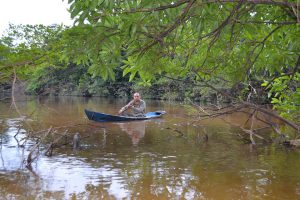 The Rio Atabapo has always fascinated me, my interest in the species that live there goes back many years in fact and I remember seeing in an old Aqualog book years ago the beautiful red Crenicichla sp that lives there. Having studied Pterophyllum altum for a very long time, I eventually came across the work of Jacques Pellegrin, who described the species from its type locality at San Fernando and knew I just had to go. I created and run the Pterophyllum altum Facebook page (https://www.facebook.com/pages/Pterophyllum-Altum/123802014346802) which Heiko also occasionally helps with and so when I got the message from Heiko asking me to go to the Atabapo, I knew I could not hesitate. The Atabapo is a wonderful tea coloured river with a strong flow, when you swim away from the shore it is almost hopeless to expect to get
The Rio Atabapo has always fascinated me, my interest in the species that live there goes back many years in fact and I remember seeing in an old Aqualog book years ago the beautiful red Crenicichla sp that lives there. Having studied Pterophyllum altum for a very long time, I eventually came across the work of Jacques Pellegrin, who described the species from its type locality at San Fernando and knew I just had to go. I created and run the Pterophyllum altum Facebook page (https://www.facebook.com/pages/Pterophyllum-Altum/123802014346802) which Heiko also occasionally helps with and so when I got the message from Heiko asking me to go to the Atabapo, I knew I could not hesitate. The Atabapo is a wonderful tea coloured river with a strong flow, when you swim away from the shore it is almost hopeless to expect to get 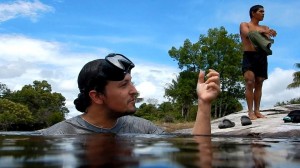 far and after some time you will ask yourself, “where on Earth does all this water come from?”. The whole region is extremely mineral deficient and this means that every creature is ready to take advantage of its opportunity. When you sweat in the hot sun, you are very soon surrounded by harmless bees and butterflies trying to exploit the salt from your skin. We had a swarm of large red bumblebees surrounding our empty food pot and actually fighting (pushing each other) to get to the tiniest mineral deposits; An interesting place and exceptionally beautiful, the landscape is mostly igneous granite rock which forms the beautiful fine white sand when eroded. As I entered the water with some remaining mosquito bites on my legs (from Brasil), I could feel the acidity… But after a week or so there, when I returned to England my skin was smoother, natural remedy?
far and after some time you will ask yourself, “where on Earth does all this water come from?”. The whole region is extremely mineral deficient and this means that every creature is ready to take advantage of its opportunity. When you sweat in the hot sun, you are very soon surrounded by harmless bees and butterflies trying to exploit the salt from your skin. We had a swarm of large red bumblebees surrounding our empty food pot and actually fighting (pushing each other) to get to the tiniest mineral deposits; An interesting place and exceptionally beautiful, the landscape is mostly igneous granite rock which forms the beautiful fine white sand when eroded. As I entered the water with some remaining mosquito bites on my legs (from Brasil), I could feel the acidity… But after a week or so there, when I returned to England my skin was smoother, natural remedy?
- What are water parameters there and did you find something exciting there? Maybe some fishes, plants,…
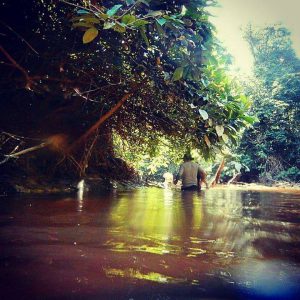 The parameters varied a little between different places along the atabapo, but not very much. The main river has a pH always around 3.7 but one or two creeks had slightly higher pH values at around 4.3, conductivity was typically around 12μS up to around 14μS and the temperature was usually around 29-30°C but sometimes a degree higher or lower and in some places the surface temperature could be 31°C, but only 1 metre below 27°C and so on.. We found many interesting fish there, I have just completed a 2000+ word article with many photos all about it, which will be in the April edition of Practical Fishkeeping Magazine (available from the end of February), they have online subscription available; the only aquatic plant we found in the region was Cyperus which lined many of the shores and grows both in and outside of the water.
The parameters varied a little between different places along the atabapo, but not very much. The main river has a pH always around 3.7 but one or two creeks had slightly higher pH values at around 4.3, conductivity was typically around 12μS up to around 14μS and the temperature was usually around 29-30°C but sometimes a degree higher or lower and in some places the surface temperature could be 31°C, but only 1 metre below 27°C and so on.. We found many interesting fish there, I have just completed a 2000+ word article with many photos all about it, which will be in the April edition of Practical Fishkeeping Magazine (available from the end of February), they have online subscription available; the only aquatic plant we found in the region was Cyperus which lined many of the shores and grows both in and outside of the water.
- What do you think about our intention of founding discus club in Croatia. It is first club in this part of Europe
I think that if there are individuals who are passionate enough about Discus fish to go to the effort to create, manage and meet regularly at a club where they can share their interest and help teach others (including the younger generation), then this is always going to be a good thing. I am very proud to see this happen and especially in a place where it has not been done before. I know the Discus Club Croatia will make great achievements in the Discus community, the passion you all demonstrate is inspiring and I wish you all the very best for the future; you have my full support.
- Beside this questions are you have something to add what you think is important for discus keepers and breeders?
For Discus keepers, I would like to recommend that before keeping any species or strain, you must take the time to research the living conditions of the fish (whether wild or tank bred), try your best to recreate that for the fish you purchase and remember to aim to help them thrive rather than just to survive. In nature, Discus fish live in very large shoals of up to several hundred and so if I would set any one rule in stone, it would be to buy what you consider a shoal of fish (typically a minimum of at least 8 or more), but better a large group of unrelated juveniles which you can later select the best from.
For Discus breeders, I would like to encourage more integration of wild genes for strains which hold equal traits (such as Turquoise), this is beginning to happen in Europe already, and more out-crossing or further separated line breeding when trying to achieve new or nonconforming traits. The process to achieve them will take a little longer, but the quality of the final fish and their fertility will be greater, instances of deformation and required culling will be less also; this is what is best for the future of the domestic discus, especially those variants which are man made.
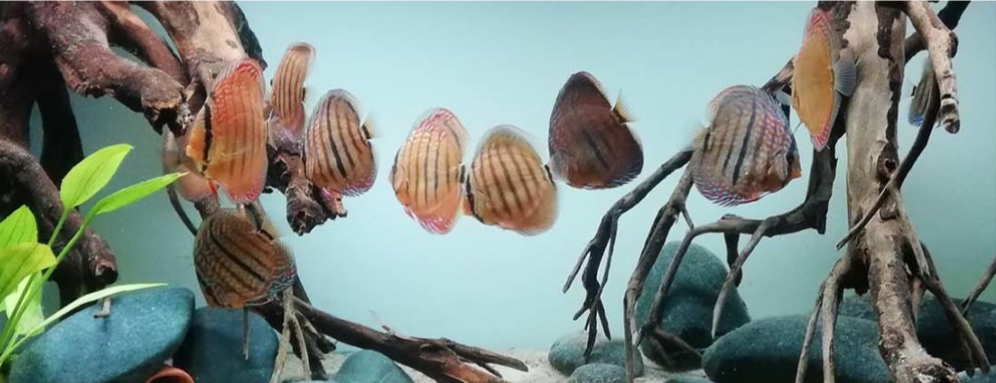


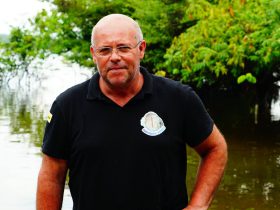


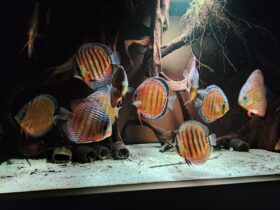





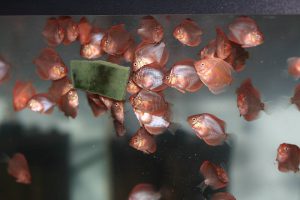




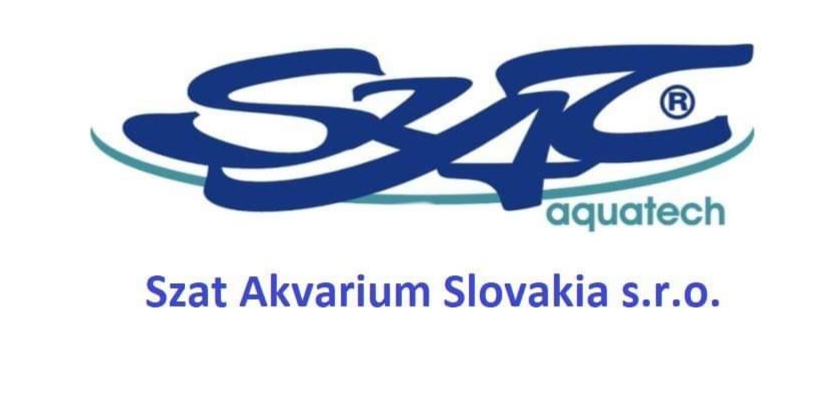
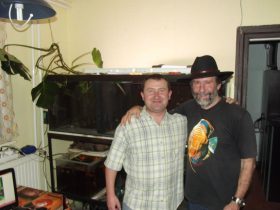

Ostavi Recenziju